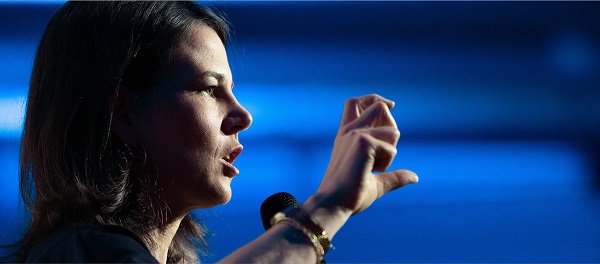International
Is Russia at War With Ukraine, or With the West?

|
German Foreign Minister Annalena Baerbock this week, on entering a “new era of nefariousness”:
I say clearly and across the Atlantic, what is right and what is wrong shall never be irrelevant to us. No one wants and no one needs peace more than the Ukrainians and Ukraine. The diplomatic efforts of the U.S. are of course important here. But such a peace must be just and lasting and not just a pause until the next attack… We will never accept a perpetrator-victim reversal. A perpetrator-victim reversal would be… the end of security for the vast majority of countries. And it would be fatal for the future of the United States.
Baerbock’s declaration that a “perpetrator-victim reversal” (a Täteropferumkehr, I’m reliably informed) would be “fatal” to the U.S. was historic. It was accompanied by a promise that “as transatlantacists,” Europeans must “stand up for our own interests, our own values, and our own security.” Although new leaders are ready to take the reins in Germany, she said, there can be no waiting for the transfer of power. Immediately, “Germany must take the lead at this historic milestone.”
A few years ago Baerbock pleaded for patience with a British conservative who demanded to know why Germany wasn’t providing Leopard tanks to Ukraine.
Now, with Donald Trump cutting off weapons deliveries and shutting down access to ATACMS missiles, Baerbock’s speech is an expression of more enthusiastic European support for continued fighting.
The war in Ukraine is often called a proxy conflict between Russia and the West or Russia and the U.S., but it increasingly looks more like a fight between Baerbock’s “transatlanticists” and those who believe in “spheres of influence.” In preparing Racket’s accompanying “Timeline: The War in Ukraine,” I found both sides articulated this idea repeatedly.
In January, 2017, as he was preparing to relinquish his seat to Mike Pence, Joe Biden alluded to the recent election of Donald Trump in a speech at Davos. Describing the “dangerous willingness to revert to political small-mindedness” of “popular movements on both the left and right,” Biden explained:
We hear these voices in the West—but the greatest threats on this front spring from the distinct illiberalism of external actors who equate their success with a fracturing of the liberal international order. We see this in Asia and the Middle East… But I will not mince words. This movement is principally led by Russia.
Biden even then lumped Trump and Putin together, as enemies of the “liberal international order.” Russian counterparts like Putin and Foreign Minister Sergei Lavrov, meanwhile, spoke of a “post-West world order” where diplomatic relations would be based on “sovereignty” and the “national interests of partners.” These are two fundamentally irreconcilable worldviews. Was conflict inevitable, or could peace have held if Russia didn’t strike in 2022?
There’s no question who invaded whom. Hostilities began in February, 2022 with an angry speech by Vladimir Putin and bombs that landed minutes later in Ukraine. Little discussion of the “why” of the war took place in the West, however.
Phrases like “unprovoked aggression” became almost mandatory in Western coverage. Politico interviewed a range of experts and concluded that what Putin wanted was “a revanchist imperialist remaking of the globe to take control of the entire former Soviet space.” This diagnosis of Putin’s invasion as part of a Hitlerian quest for Lebensraum and a broader return to national glory might have merit, but it was also conspicuously uncontested. A differing article by University of Chicago professor John Mearshimer declaring the crisis “the West’s fault” made him, as The New Statesman just put it, “the world’s most hated thinker.” Few went there after.
Russians and Ukrainians don’t have the typical profiles of ancient warring tribes. They have a deeply intertwined history, with citizens of both countries retaining many of the same customs, jokes, and home remedies, while living in the same crumbling Soviet buildings, with fondness for the same cabbage soup and moonshine. There are huge numbers of mixed/bilingual families and many famous cultural figures (including my hero Nikolai Gogol) are claimed by both countries. They’ve fought before, but what jumped out reviewing this “Timeline” is how much it seemed that these old Slavic neighbors mostly fall out now over attitudes toward the West.
It’s hard looking back not to be struck by the superior tone of bodies like the Organization for Security and Co-operation in Europe (OSCE), whose “reviews” of Ukrainian and Russian elections often read like zoological descriptions of inferior species. Same with a tsk-tsking report by a mission of visiting IMF economists in 2013, who were appalled by Ukrainian energy subsidies that were among of the few popular remnants of Soviet life.
These imperious Western assessments of childlike Slavs, and the panic and shame of some local officials before such foreign judgments, recall familiar satires in Russian literature (The Government Inspector comes to mind). Nationalists in both countries balked at this “advice,” and by the late nineties some came to the conclusion that the cost of cooperation with the West was greater than the benefit. These dynamics accelerated after the Orange Revolution in 2004 and the Maidan events of 2013-2014, which Russians still see as a West-backed coup and the beginning of the current war. Russians will say “first blood” was drawn in military operations against Donbass protesters around the same time. Those in the West will point at the 2014 annexation of Crimea as the beginning of territorial war.
The idea of Germany “taking the lead” in a war to secure the primacy of “transatlanticists” worries me more than trying to pronounce Täteropferumkehr. However, whether or not you think Baerbock is right, and a peace deal now would be a worthless “pause,” depends a lot on how you read this history. What do you think, and why?
Censorship Industrial Complex
A Democracy That Can’t Take A Joke Won’t Tolerate Dissent

From the Frontier Centre for Public Policy
By Collin May
Targeting comedians is a sign of political insecurity
A democracy that fears its comedians is a democracy in trouble. That truth landed hard when Graham Linehan, the Irish writer behind Father Ted and The IT Crowd, stepped off a plane at Heathrow on Sept. 1, 2025, and was met by five London Metropolitan Police officers ready to arrest him for three posts on X.
Returning to the UK from Arizona, he was taken into custody on the charge of “suspicion of inciting violence”, an allegation levelled with increasing ease in an age wary of offence. His actual “crime” amounted to three posts, the most contentious being a joke about trans-identified men in exclusively female spaces and a suggestion that violated women respond with a swift blow to a very sensitive part of the male’s not-yet-physically-transitioned anatomy.
The reaction to Linehan’s arrest, from J.K. Rowling to a wide array of commentators, was unqualified condemnation. Many wondered whether free speech had become a museum piece in the UK. Asked about the incident, British Prime Minister Keir Starmer defended his country’s reputation for free expression but declined to address the arrest itself.
Canada has faced its own pressures on comedic expression. In 2022, comedian Mike Ward saw a 12-year legal saga end when the Supreme Court of Canada ruled five-to-four that the Quebec Human Rights Commission had no jurisdiction to hear a complaint about comments Ward made regarding a disabled Quebec boy. The ruling confirmed that human rights bodies cannot police artistic expression when no discrimination in services or employment has occurred. In that case, comic licence survived narrowly.
These cases reveal a broader trend. Governments and institutions increasingly frame comedy as a risk rather than a social pressure valve. In an environment fixated on avoiding perceived harm, humour becomes an easy and symbolic target. Linehan’s arrest underscores the fragility of free speech, especially in comedic form, in countries that claim to value democratic openness.
Comedy has long occupied an unusual place in public life. One of its earliest literary appearances is in Homer’s Iliad. A common soldier, Thersites, is ugly, sharp-tongued and irreverent. He speaks with a freedom others will not risk, mocking Agamemnon and voicing the frustrations of rank-and-file soldiers. He represents the instinct to puncture pretension. In this sense, comedy and philosophy share a willingness to speak uncomfortable truths that power prefers to avoid.
Aristotle, in his Poetics, noted that tragedy imitates noble actions and depicts people who are to be taken seriously. Comedy, by contrast, imitates those who appear inferior. Yet this lowly status is precisely what gives comedy its political usefulness. It allows performers to say what respectable voices cannot, revealing hypocrisies that formal discourse leaves untouched.
In the Iliad, Thersites does not escape punishment. Odysseus, striving to restore order, strikes him with Agamemnon’s staff, and the soldiers laugh as Thersites is silenced. The scene captures a familiar dynamic. Comedy can expose authority’s flaws, but authority often responds by asserting its dominance. The details shift across history, but the pattern endures.
Modern democracies are showing similar impatience. Comedy provides a way to question conventions without inviting formal conflict. When governments treat jokes as misconduct, they are not protecting the public from harm. They are signalling discomfort with scrutiny. Confident systems do not fear irreverence; insecure ones do.
The growing targeting of comedians matters because it reflects a shift toward institutions that view dissent, even in comedic form, as a liability. Such an approach narrows the space for open dialogue and misunderstands comedy’s role in democratic life. A society confident in itself tolerates mockery because it trusts its citizens to distinguish humour from harm.
In October, the British Crown Prosecution Service announced it would not pursue charges against Linehan. The London Metropolitan Police Service also said it would stop recording “non-crime hate incidents”, a controversial category used to document allegations of hateful behaviour even when no law has been broken. These reversals are welcome, but they do not erase the deeper unease that allowed the arrest to happen.
Comedy survives, but its environment is shifting. In an era where leaders are quick to adopt moral language while avoiding meaningful accountability, humour becomes more necessary, not less. It remains one of the few public tools capable of exposing the distance between political rhetoric and reality.
The danger is that in places where Agamemnon’s folly, leadership driven by pride and insecurity, takes root, those who speak uncomfortable truths may find themselves facing not symbolic correction but formal sanctions. A democracy that begins by targeting its jesters rarely stops there.
Collin May is a Senior Fellow with the Frontier Centre for Public Policy, a lawyer, and Adjunct Lecturer in Community Health Sciences at the University of Calgary, with degrees in law (Dalhousie University), a Masters in Theological Studies (Harvard) and a Diplome d’etudes approfondies (Ecole des hautes etudes, Paris).
Daily Caller
Tech Mogul Gives $6 Billion To 25 Million Kids To Boost Trump Investment Accounts


From the Daily Caller News Foundation
Billionaire Michael Dell and his wife, Susan, announced Monday that they will give 25 million American children a $250 deposit as an initial boost to President Donald Trump’s new investment program for children.
The Dells’ pledge totals $6.25 billion and will be routed through the Treasury Department. The goal, they say, is to extend access to the federal Invest America program — referred to as “Trump accounts” — established by the One Big Beautiful Bill Act, signed into law by the president in July.
The federal program guarantees a $1,000 federally funded account for every child born from 2025 through 2028, but the Dells’ money will instead cover children 10 years old and younger in ZIP codes where the median household income is under $150,000, according to Bloomberg.
Dear Readers:
As a nonprofit, we are dependent on the generosity of our readers.
Please consider making a small donation of any amount here.
Thank you!
“What inspired us most was the chance to expand this opportunity to even more children,” the Dells wrote in the press release. “We believe this effort will expand opportunity, strengthen communities, and help more children take ownership of their future.” (RELATED: Trump Media Company To Create Investment Funds With Only ‘America First’ Companies)
Dell, founder and CEO of Dell Technologies with a net worth of about $148 billion, has been one of the most visible corporate leaders championing the Trump accounts. In June, he joined Goldman Sachs CEO David Solomon, Uber CEO Dara Khosrowshahi, and others at a White House roundtable promoting the initiative.
In addition to the new $6.25 billion pledge, Dell Technologies committed to matching the government’s $1,000 contribution for the children of its employees. Other companies, such as Charter Communications, Uber, and Goldman Sachs, have said they are willing to match the government’s contributions when the accounts launch.
“This is not just about what one couple or one foundation or one company can do,” the couple wrote. “It is about what becomes possible when families, employers, philanthropists, and communities all join together to create something transformative.”
Starting July 4, 2026, parents will be able to open one of the accounts and contribute up to $5,000 a year. Employers can put in $2,500 annually without it counting as taxable income.
The money must be invested in low-cost, diversified index funds, and withdrawals are restricted until the child turns 18, when the funds can be used for college, a home down payment, or starting a business. Investment gains inside the account grow tax-free, and taxes are owed only when the money is eventually withdrawn.
The accounts will “afford a generation of children the chance to experience the miracle of compounded growth and set them on a course for prosperity from the very beginning,” according to the Trump administration.
The broader effort was originally spearheaded in 2023 by venture capitalist Brad Gerstner, who launched the nonprofit behind the Invest America concept.
“Starting 2026 & forevermore, every child will directly share in the upside of America! Huge gratitude to Michael & Susan for showing us all what is possible when we come together!” Gerstner wrote on X.
-

 National2 days ago
National2 days agoMedia bound to pay the price for selling their freedom to (selectively) offend
-

 Business1 day ago
Business1 day agoIs there a cure for Alzheimer’s Disease?
-

 C2C Journal1 day ago
C2C Journal1 day agoLearning the Truth about “Children’s Graves” and Residential Schools is More Important than Ever
-

 Bruce Dowbiggin2 days ago
Bruce Dowbiggin2 days agoSometimes An Ingrate Nation Pt. 2: The Great One Makes His Choice
-

 Alberta2 days ago
Alberta2 days agoNew era of police accountability
-

 Brownstone Institute1 day ago
Brownstone Institute1 day agoThe Unmasking of Vaccine Science
-

 Energy2 days ago
Energy2 days agoCanadians will soon be versed in massive West Coast LPG mega-project
-

 Alberta1 day ago
Alberta1 day agoEmissions Reduction Alberta offering financial boost for the next transformative drilling idea








